The Redwood National Park astounds visitors worldwide with some of the tallest and oldest trees. Situated on over 139,000 acres, the prospect of visiting can be overwhelming.
For this reason, we created our guide to Redwood National Park. We’ve done the heavy lifting to provide you with an information-rich resource to help you better plan your getaway.
This national park is one of the most remarkable destinations on the West Coast — or anywhere in the country! One reason it’s so popular is that it’s a day’s drive or a short flight from San Francisco, Sacramento, and Portland.
While Redwood National Park is open year-round, summer is the most popular time to visit. This is due to the sun being the sunniest from June through August and the coastal climate and trees keeping temperatures moderate. For a less crowded experience, visit during May, September, and October.
No matter when you decide to visit, each season offers unique perspectives, opportunities, and adventures on a Casago Redwood vacation.
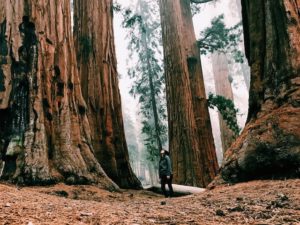
The Amazing Redwood Trees
The biggest draw to this iconic park is the Redwoods. While they grow along the coasts of Northern California and Oregon, those at Redwood National Park are astounding. They date back to BCE times, are coniferous, and can reach 300′ in height with a circumference of 20′!
Another reason the redwood attracts visitors is because it’s the tallest tree in the world. But you probably figured that out based on the 300′ height. Equally impressive is the root system. A typical redwood’s roots are only 6 to 12 feet deep, which isn’t deep considering their height. To create the strength to withstand windstorms and floods, it extends its roots up to 100′ outward.
Did you know redwoods grow in circles called “fairy rings” or “family circles”? This phenomenon is a result of younger trees sprouting from the parent. The intertwining roots provide additional strength and nutrients, enabling the “family” to grow.
Naturalists and biologists flock to the redwoods to witness the ecosystems within the branches high off the ground. Due to the redwood’s size and age, its shed leaves collect on the branches, where dust and water accumulate. Eventually, this becomes soil and is the genesis of a mini-ecosystem. Scientists have discovered ferns, moss, lichen, huckleberries, and even other full-sized trees thriving in the canopies of redwoods.
All these fantastic facts add to the redwood’s allure, attracting visitors worldwide.
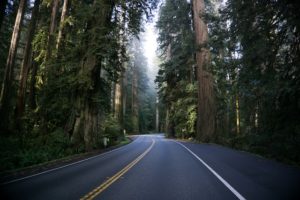
Getting to Redwood National Park
The park is located along the Northern California coast, approximately equidistance from Portland, San Francisco, and Sacramento.
If you decide to drive from either city, plan on the trip taking 5.5 hours, not including rush hour traffic.
The flights from either city are short, and the closest airport to Redwood National Park is Eureka/Arcata Regional Airport (ACV). United Airlines, American Airlines, and Avelo service this regional airport.
Once you secure your rental car, plan on a half-hour drive from ACV to Redwood National Park.
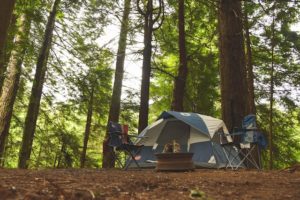
Lodging in Redwood National Park
Camping is the only lodging available in the park, with four developed campsites and seven designated backpacking sites along the 200 miles of trails.
The developed sites are Jedediah Smith, Mill Creek, Gold Bluffs Beach, and Elk Prairie Campground. Each has unique features and amenities, and some accommodate RVs. To protect the bark, hammocks and ropes are not allowed in the trees, so plan accordingly.
Reservations are strongly encouraged, especially during the busy summer season. Contact information is on any of the above links.
The seven backpacking sites along the extensive trail system let you immerse yourself in nature away from the busier developed sites. These are for those seeking a rugged, off-the-grid experience with limited cell service. Be advised that these sites are in bear and mountain lion country, and help in an emergency is far away. They also don’t have drive-up access, so you’ll need to hike, bike, ride horseback, or raft to your site.
Before heading out, you’ll need a free permit and should review the safety guidelines.
If camping isn’t your thing, there are hotels in Eureka, Arcata, and Trinidad. Additionally, Casago offers several short-term rentals in Eureka and Arcata.
Trinidad is further north and on the coast. It offers higher-end hotels, bread and breakfasts, small resorts, and Casago rentals.
Whether you stay in an RV, tent, hotel, or Casago rental, visiting the Redwood National Park will be one of the highlights of your vacation.
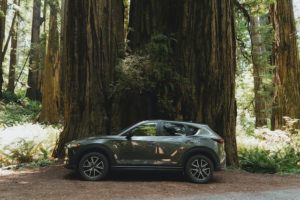
Tour Redwood National Park by Car
Exploring Redwood National Park by car is possible year-round, ideal for those who can’t hike, and keeps you warm and dry should the weather change.
Your first stop should be at any of the five visitor centers: Hiouchi, Jedediah Smith, Crescent City, Prairie Creek, and Thomas H. Kuchel.
Here, you can get a map and talk with park rangers, who are a wealth of information. They have insight regarding what areas are closed, must-visit places to see, and animal and flora updates.
Next, select any of the eight top drives at Redwood National Park! These include:
- Howland Hill Road
- Enderts Beach Road
- Requa Road
- Coastal Drive (Loop)
- Newton B. Drury Scenic Parkway
- Cal-Barrel Road
- Davison Road
- Bald Hills Road
While the summer is the most popular season to visit Redwood National Park, a driving tour can take place year-round. Be sure to review the specifics for each road, as some have limited access or aren’t paved, which may require a 4×4 vehicle.
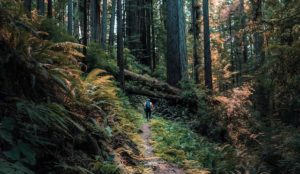
Things To Do in Redwood National Park
This natural wonderland attracts nature lovers, outdoor enthusiasts, and adventurers worldwide. So, let’s explore some things you can do when visiting Redwood National Park.
Hiking
The best way to experience the redwoods and ferns is on a hike. What makes hitting the trail at Redwood National Park so appealing is that there’s a route for every age and ability.
For a comprehensive list, check out the four best hikes in Redwood National Park to find one suitable for your group and timeframe.
Ranger-led Programs
When you want an educational yet fun Redwood experience, sign up for any ranger-led programs. These are offered mid-May through late September and appeal to all ages.
The guided forest walks last about an hour and offer an immersive look into the vast ecosystems. Visitors should bring water and snacks for the hike.
Discover marine life along the California coast on a tour of the tidal pools or kayak on the Smith River, California’s largest free-flowing river system.
The campfire programs at Jedediah Smith, Mill Creek, and Elk Prairie Campgrounds offer stories, slides, interactive activities, and a campfire!
Biking
Another fun and healthy way to explore the Redwood National Park is by bike! The park has trails and roads for mountain, road, and e-bikes. However, because some trails cross into the state parks where regulations differ, e-bikes aren’t permitted. These include:
- Little Bald Hills Trail
- Coastal Trail – Last Chance Grade Section
- Ossagon Trail
- Coastal Trail – Gold Bluffs Beach Section
Most trails are old logging roads that reduce erosion and are wide enough for multiple users.
Road cyclists will enjoy the Newton B. Drury Scenic Parkway, a 10-mile paved surface that is mainly flat. However, a one-mile section near the northern section has 400 feet of elevation gain, so plan accordingly.
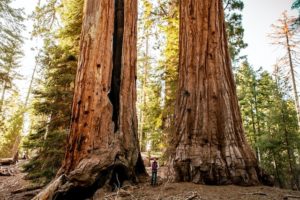
Explore with Confidence!
No matter when you visit or how long you stay, experiencing the redwood trees and ferns will be an experience you won’t forget. We hope our guide to Redwood National Park has simplified your planning and excited you to explore this national treasure.
Aside from the national park, check out these things to do on your Casago Redwood vacation to add to your adventures.
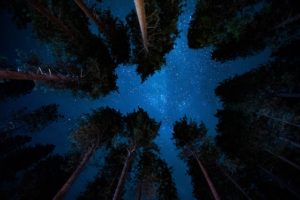
Updated 2025


.svg)



[…] miss Tall Trees Grove and Fern Canyon for their beauty. These spots show off the trees’ grandeur and unique […]
[…] Humboldt, this park is a treasure trove of old-growth redwoods, trails, and campgrounds. Check out Our Guide to Redwood National Park for an insider’s guide to […]
Very informative, to the dream forest , where I want to go this month of May!
How should I arrange for a tour to the coastal Redwoods with Casago? I will try AAA first!
Thanks for all primary. information for my forthcoming
Visit to that beautiful “neck of the woods!” A ☺